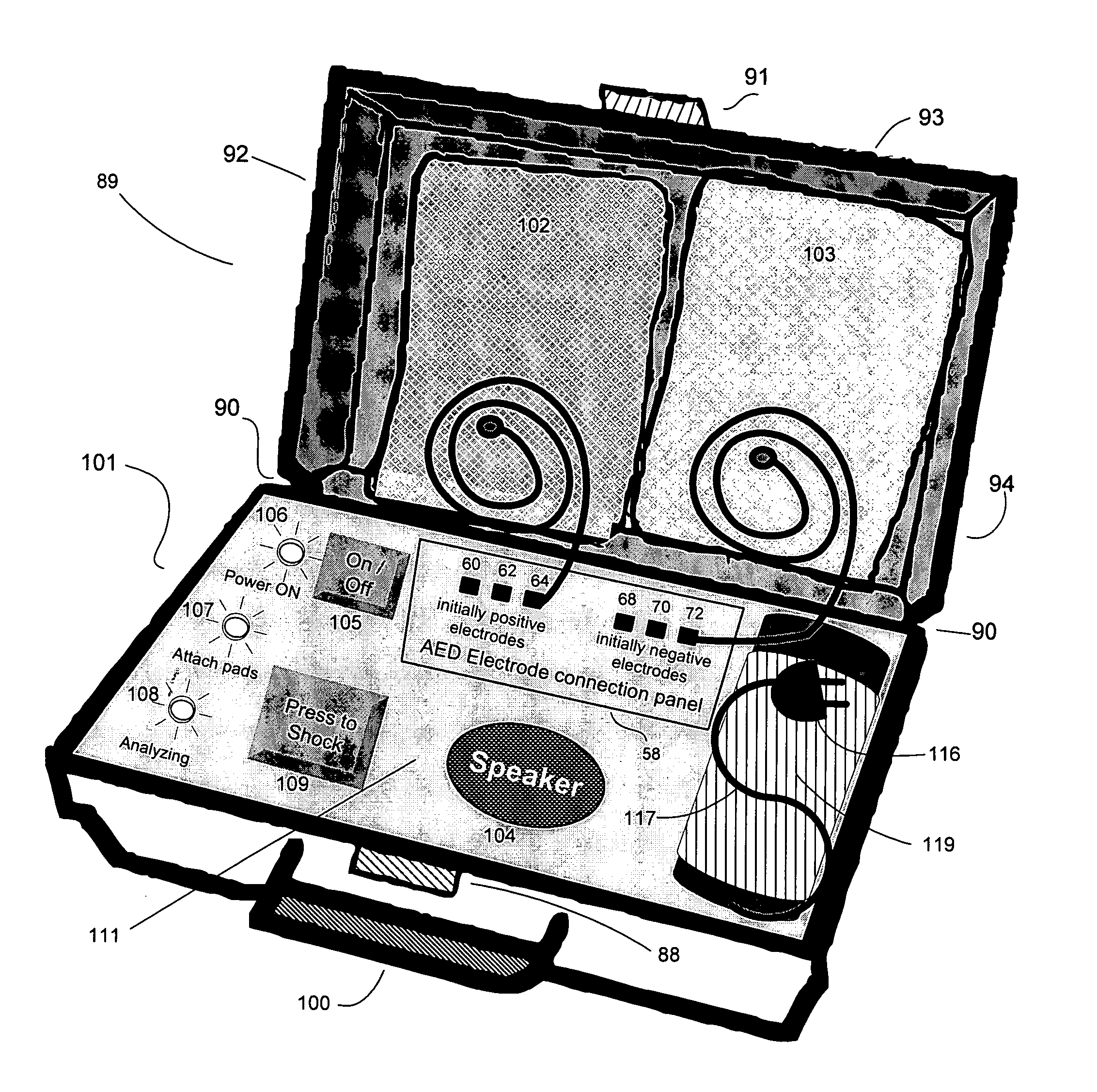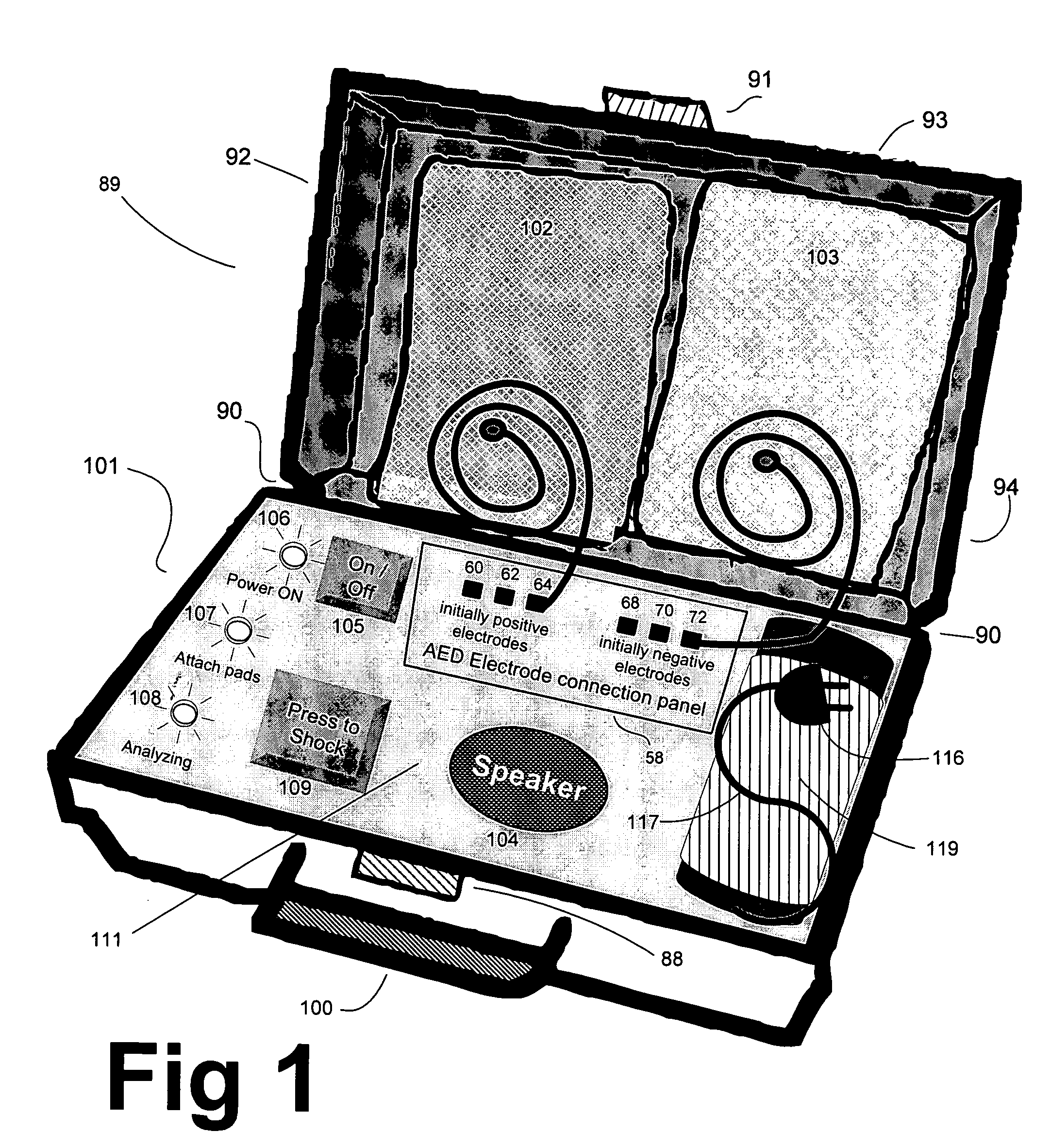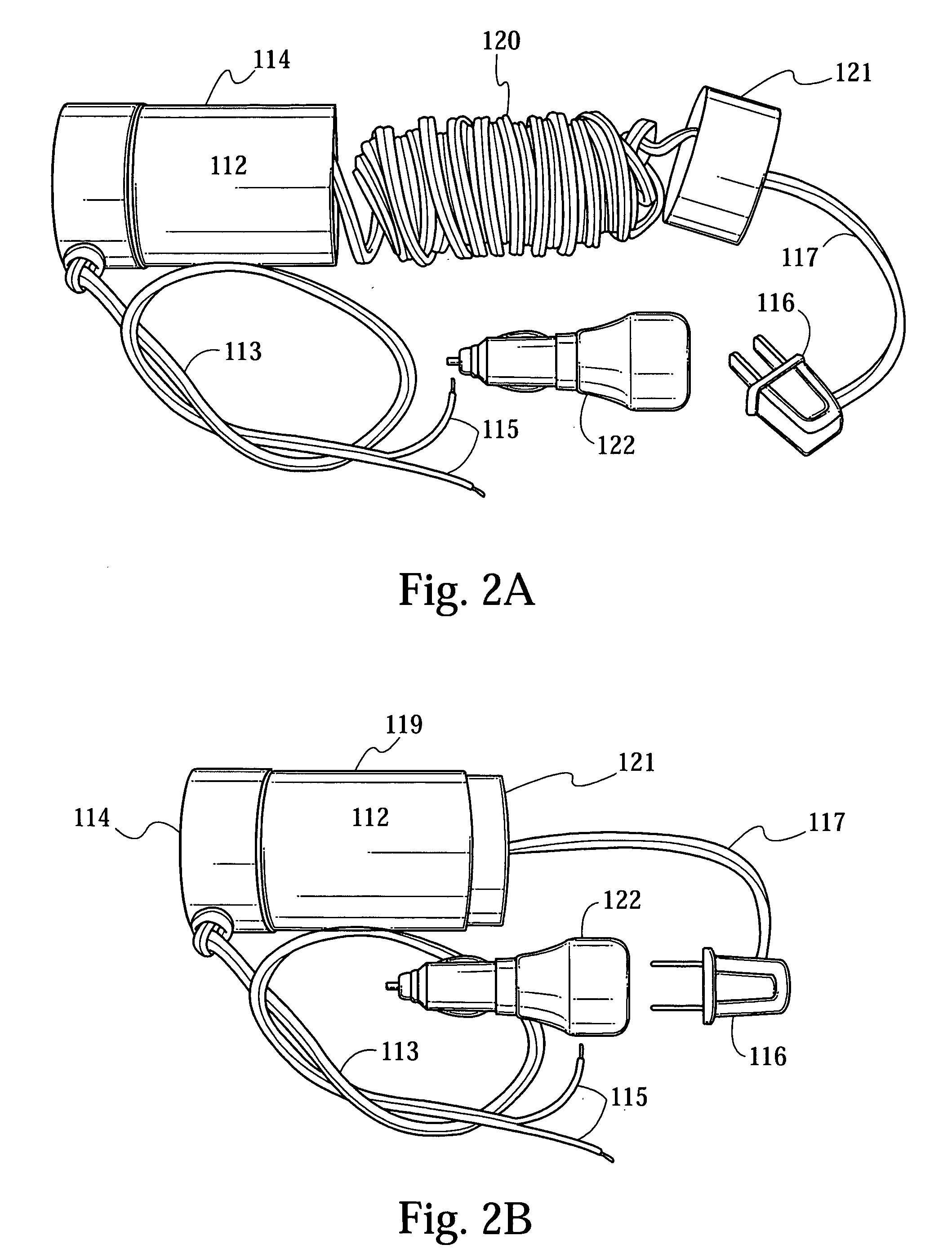The most fundamental similarity, and problem, in all of the prior art AEDs is the design approach in which all prior art AEDs contain at least one or more internal-integral batteries as their sole and exclusive source of power for all functions, both essential functions like
ECG analysis and the creation and delivery of the defibrillation shock, and non-essential functions like continuously self testing the unit and the batteries, which actually then runs down the batteries.
Though they can create this sometimes essential
portable power, the problems with internal-integral AED batteries are many.
Dead or weak AED batteries, due to age, internal defects, or multiple prior uses without subsequent testing or replacement, can render an AEDs totally useless in the crucial moments when it is greatly needed to actually save an SCA victims life.
In a less dramatic form of battery malfunction, the battery may simply be weak from age or prior use and hence is very slow in charging the
high energy storage capacitors prior to shock delivery; such charging must be done each time before the AED can deliver a shock to defibrillate the patient.
This
delay in charging from a weak battery is unacceptable when every second counts.
If three shocks are required, such weak batteries can result in
brain damage by consuming 90 seconds of valuable time waiting for the completion of charging.
This presence of internal-integral AED batteries also leads to other AED problems such as limited
shelf life, since all batteries
discharge with the passage of time even if they are not actually being used to save lives, and generally two years is the recommended interval of battery replacement even if not used.
This two year battery
shelf life, (as well as the typical two year shelf life of electrodes), limits the shelf life of current AEDs to approximately two years.
Additionally, since batteries powerful enough to supply the
high energy shocks required are relatively heavy, they increase the weight and size of AEDs.
The use of internal-integral batteries as the sole source of power in all existing AEDs also requires additional
electronics to create the
high voltage needed for defibrillation from the
low voltage DC batteries, such additional
electronics further increasing costs and weight.
However, the most dramatic problem with internal-integral AED batteries is exceptionally alarming.
Since these batteries are small electrochemical energy plants, which produce a limited amount of
electricity used to power the AED, if there is a battery malfunction there can be excessive heat generated, essentially an electrochemical
plant meltdown, with consequent destruction of the battery itself and potential damage to the rest of the AED, rendering the AED useless even with a new battery.
In extreme cases, instances of which have been reported to the FDA, the AED's battery can actually explode and injure the user as well as destroying the AED itself.
The purpose of this routine maintenance is to reduce the likelihood of battery explosions or premature or unknown battery exhaustion, any of which will render the AED useless for defibrillation and potentially hazardous to the operator as well.
However, these battery maintenance requirements of existing AEDs must be scheduled and their performance tracked; further, they are
time consuming, relatively complicated, and require some technical knowledge and even in some cases mathematical calculation to accurately track the
remaining life in the battery as time passes.
Hence, these maintenance requirements are, as a practical matter, not achievable by some EMS professionals and surely not achievable by most lay persons who would like to have access to a "Personal AED" in their home or workplace.
However, the requirement to perform such a test must be remembered by the user and the testing takes time and also uses up some of the
battery capacity during the test.
Many AEDs are designed to have automatic self tests run periodically, which is convenient and can provide a warning that battery life is low; however, these self tests also consume some of the battery's capacity, consequently reducing the shelf life of the battery and consequently of the shelf life of the AED itself.
However, if the battery has actually failed completely, the
self test will not work at all, and if the user is not very familiar with the operation and maintenance of the AED, they will not be aware of the presence of a dead battery.
Even More Problems with Internal-Integral Battery Power in Existing AEDs
An additional problem with the batteries used in most AEDs is that they are special designs and special shapes designed to mate with a specific AED from a single manufacturer.
Obviously, such specialized batteries are not available except from the manufacturer and hence are not readily available when replacement is needed.
Also, they are expensive, often costing as much as $100-$200 each.
This excessive cost results in a reluctance for users to routinely replace them even when not used, and hence, there will be times when the AED is needed, but the battery is dead or very weak, and no replacement is readily available.
The lack of a functioning AED internal-integral battery is a truly fatal deficiency in the case of the need to assist a person with SCA, since it is to be clearly understood, that when a person has
ventricular fibrillation (VF) there is no treatment that will restore an effective
heart beat other than defibrillation with a high power shock from a defibrillator.
This additional expense incurred by an AED design that uses one or more internal-integral batteries for its power consists of both the cost of the large powerful battery itself, but also for the additional circuitry which is required to convert the relative
low voltage of the battery to the
high voltage energy required for successful defibrillation.
Similarly, as mentioned above, replacement batteries cost significantly, and since all batteries have a finite shelf life, an AED's battery must be replaced periodically even if not actually used for defibrillation.
Such a multi-battery design also introduces additional reliability issues over those of single internal-integral battery AED design, since there are many more mechanical contacts associated with mounting all ten batteries as compared to designs that use a single large battery.
Such mechanical contacts are often a source of failure in electronic devices of any kind and having twenty of them increases the probability of a
contact failure.
However, the rechargability of these batteries introduces new, undesirable variables such as the need and cost for a charger, and the need to recharge the batteries frequently whether used or not, since rechargeable batteries typically have a "self-
discharge" rate much greater than non-rechargeable batteries.
Many rechargeable batteries also have a well known "
memory effect" that reduces
battery capacity, often to unknown levels, if not properly conditioned periodically by three complete
charge and discharge cycles, difficult for trained EMS professionals, but a true impracticality for an individual with a personal AED in their home.
The design of the AED to make the internal-integral
power battery easily user replaceable also increases cost and mechanical / electrical complexity for the overall AED.
There are other problems with existing AEDs in addition to the problems associated with using batteries as their
energy source.
Current AEDs are also designed for high
visibility in public places or EMS vehicles and as such, these AEDs look ugly in a person's home or workplace if visibly placed so that they are easily accessible for rapid use.
Although the highly visible colors and
enclosure design of existing AEDs have great value for
public access, such as in airports and shopping malls, these bright colors of existing AEDs become a very negative aesthetic aspect of existing AEDs for home and office use.
This negative visual aesthetic aspect of existing AEDs will often prevent the AED from being placed in an ideal location in the home or workplace such as a central location where it can be quickly and easily accessed in the event of an SCA, and not hidden away in a
closet or drawer because it is obvious and ugly.
Just as in the case of internal-integral batteries and their great utility when portability is needed (despite their well known reliability and cost problems), high
visibility is also a very desirable feature for
public access AED placements, but is highly undesirable in other AED placements such as in homes and offices where it is desired that the personal AED be placed aesthetically and centrally so as to be at the ready for
rapid access and immediate use when needed.
1) high acquisition cost for a device that may never be used even once,
2) required
periodic testing by the owner, plus the maintenance and replacement of batteries and electrodes every two years to assure reliability even when the AED is not actually used,
3) short shelf life due to exclusive power by internal-integral batteries,
4) visually and aesthetically not suited for placement in a central location since existing AEDs are visually very obvious, and considered ugly visually in a
home environment, and,
5) mandatory AED refurbishment by the user after an
actual use or shelf life expiration.
Clearly, the existing AED business model, integrated with the existing AED design, is not designed for, and not conducive to, the widespread availability of AEDs in the average person's home or workplace.
For "Private access" defibrillation using "Personal AEDs" , the problems with the existing AED business model, as well as the existing multiple-use AEDs are described above, and are severe.
For instance, those persons that wish to have the security and comfort of knowing that an AED is no more than seconds away from them in their home or workplace must purchase an AED which is actually designed for multiple-uses and for user refurbishment in the field, both of which increase costs and complexity for the nonprofessional user.
For AED deployment into private homes, where it is very improbable that a personal AED will be used more than once in 4 years, (and in most cases the personal AED will never be needed and never used, just like most home fire extinguishers are never needed and never used), there is a severe mismatch between the needs of these users needing private access AEDs and the design, complexity of maintenance, and costs of existing AEDs.
This tragedy will usually result in the death of the SCA victim, who would probably have been saved otherwise.
However, even with the regular AED return and refurbishment service, the user is without their personal AED for less than 24-48 hrs after the use of their original AED on a patient.
 Login to View More
Login to View More  Login to View More
Login to View More 


